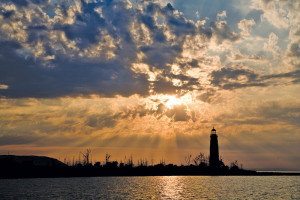Can we save the two remaining icons of our marine heritage?
by Janet Lees
 The Collingwood Terminals grain elevators and the Nottawasaga Island Lighthouse are arguably the two local landmarks most closely identified with Southern Georgian Bay. Reminders of the days when Collingwood was a thriving shipping port known as “The Chicago of the North,” today the future of both of these important icons is uncertain.
The Collingwood Terminals grain elevators and the Nottawasaga Island Lighthouse are arguably the two local landmarks most closely identified with Southern Georgian Bay. Reminders of the days when Collingwood was a thriving shipping port known as “The Chicago of the North,” today the future of both of these important icons is uncertain.
The Lighthouse
The lighthouse is perhaps the most urgently in need of intervention. Built in the 1850s, one of six “Imperial Towers” on Georgian Bay, the lighthouse operated for 124 years, guiding mariners around treacherous shoals and through many a storm into Collingwood Harbour. The light was decommisioned in 2003, and today all is dark on “lighthouse island,” now home to hundreds of nesting migratory birds. The vegetation is decimated and the lighthouse itself is crumbling.
After a huge slab of the outer wall broke off in 2004, federal funding covered a $230,000 “band-aid” fix – the 86-foot limestone tower was basically shored up and reinforced. And that’s where the work ended. Meanwhile, the estimated cost of fully restoring the lighthouse has gone from $1.5 million to $4.5 million to – in today’s numbers – $8 million-plus (this according to Collingwood Mayor Chris Carrier).
The lighthouse has the highest heritage value that can be assigned, and there’s also an emotional pull for many in the community. “It is difficult to describe the feeling, the attachment one has for this property, but the affinity is strong,” said Carrier. “I hope the federal government acts to protect and preserve the lighthouse.” The reason it’s up to the feds to act is that the lighthouse comes under the purview of the Department of Fisheries and Oceans (DFO) – which doesn’t currently have a budget for historic restoration.
Carrier said he met with DFO officials in Ottawa on August 25. “We are awaiting a response from DFO in relation to the recent piece of legislation passed that should protect heritage lighthouses such as this one,” he said. “Our concern is that DFO has determined the lighthouse is surplus to its needs and therefore the federal government may not be obligated to protect this asset as it has no navigational functional value.”
Both Carrier and Jim Kilgour, chair of the Harbourlands Committee, agree that the best scenario would be for the federal government to pay for most or all of the restoration, then hand the lighthouse over to the town.
“I believe the local communities would take ownership provided the federal government funded the restoration but with all that communities are legislated to do in infrastructure improvements, none of us at the local level can afford to fulfill the federal government’s obligation,” said Carrier.
“My biggest concern is that while all of us engage in talk, there is limited time available to protect this beautiful historic lighthouse from further deteriorating or, even worse, falling over.”
Kilgour says both local and federal politicians have a key role to play in lobbying for action. “My feeling is that council needs to focus more on the lighthouse and start to lobby to get the work done, but at the moment council seems focused on other things,” said Kilgour. He added Helena Guergis, MP for Simcoe-Grey “needs to beat the bushes and push like hell and not accept no for an answer.” Guergis did not respond to On The Bay’s request for an interview.
Unless something happens soon, the fate of the lighthouse is dim.
The Grain Elevators
Visible for miles, the imposing Collingwood Terminals building is a symbol of the “twin engines of commerce” in the early 1900s: agriculture and shipping. Built in 1929, the two-million-bushel grain elevator has bins 100 feet high and 22 feet in diameter. Grain service stopped in 1993, marking the end of 64 years of operation for the elevator. Today the terminal building is owned by the Town of Collingwood and has been declared “surplus,” meaning it can be sold.
Mayor Carrier says he has been privy to three offers on the building as a member of previous councils. The most recent proposal, from developer Fram/Slokker, was to build condos onto the water-facing side of the building, keeping the town-facing façade intact. That plan never really got off the ground, as Fram became focused on obtaining town approvals to move forward with its Shipyards development on the land adjacent to the elevators.
Shipyards site manager Tara Parsons says the developer has no plans to put forward any further proposals regarding Collingwood Terminals, and Carrier says he is “not aware of any current development proposals or offers on this site.” Other cities have repurposed their out-of commission silos as chic apartments, cool hotels, and artist studios. Asked what he sees as the “highest and best use” for this town landmark, Carrier responded: “I have been on top of the grain elevators at least four times, maybe five. The view is fantastic. Artists would love it for photography, painting or sketching. Fishermen would love it because, boy, can you see the salmon on a clear day.” Councillor Sonny Foley says, “it would make a wonderful club,” a restaurant and convention facility, or a hotel.
Since the elevator is part of the Collingwood Heritage Conservation District, it is likely that the only future proposals council will entertain will be those that involve “repurposing” the building rather than tearing it down or significantly altering it.
Said Carrier, “This landmark is an icon and should stay as such. It is a wonderful tribute to our past. I am open to suggestions for the future use but … one that is respectful of the community’s right to be involved in the process.” ❧













